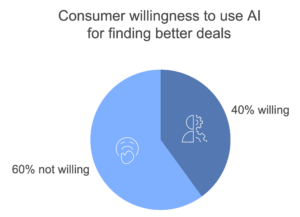Shoppers prefer existing methods over generative AI tools
Most shoppers stick with what works. They’ve developed habits that feel reliable, convenient, and straightforward. Generative AI tools, as fascinating as they are, don’t yet resonate with these consumers because the value proposition isn’t immediately obvious. They’ll only switch if the advantages are clear and compelling.
According to a Bain & Co. survey of 700 consumers, the main reason for avoiding AI tools is simple: shoppers are happy with their current methods. Think about it, they’re not necessarily anti-technology, they’re just not convinced that generative AI will make their lives easier or their shopping experiences better. This satisfaction creates inertia. Breaking through it requires showcasing real, undeniable benefits.
Where does the opportunity lie? People love finding great deals and getting personalized recommendations that feel tailored to them, not generic suggestions. If generative AI can make that happen—finding the best prices faster or curating product options that match personal tastes—then adoption could surge. Here’s the catch though: the benefits have to be so obvious that they outweigh the comfort of the familiar.
What’s the message for retailers? Don’t build AI solutions because it’s trending. Solve real shopper problems, make life easier, and show people why switching is worth it. When the rewards are crystal clear, shoppers will be willing to embrace change.
GenAI is complementing traditional experiences
The secret to making generative AI click with shoppers lies in subtlety. People don’t want their routines disrupted, they want enhancements that blend quietly into what they’re already doing. Think of it like upgrading software without the user even noticing—it just works, and it’s better.
Here’s an interesting stat: Bain’s research found that 70% of shoppers had interacted with generative AI while shopping but didn’t even realize it. That’s a huge opportunity. It means consumers are already experiencing the technology in small ways, like product review summaries or personalized recommendations, without having to change their habits. This stealthy integration is exactly where genAI shines.
Picture this: you’re browsing an online store, not sure which product to choose. Instead of sifting through countless reviews, a concise AI-generated summary tells you what most customers loved—or didn’t. That’s value right there, and it fits perfectly into the shopper’s flow. No extra steps, no learning curve, just better information at the right time.
Retailers need to think strategically here. GenAI doesn’t need to dazzle shoppers with futuristic tools, but it does need to make the everyday journey smoother, faster, and more intuitive.
Personalization is a standout use case for genAI
Today’s shoppers expect personalization. People want recommendations that feel tailored to their unique preferences, whether it’s hobbies, favorite brands, or even specific styles. Generative AI can make this happen, and it’s doing so in ways that feel natural and engaging.
Bain’s survey also showed that shoppers are most open to sharing information about their personal interests if it leads to better shopping experiences. It’s not surprising—when AI knows your favorite sports, your go-to skincare brand, or the tech gadgets you’re eyeing, it can curate options that feel spot-on.
Gartner’s research adds another layer to this: 2 in 5 consumers would gladly use AI tools to find better deals. People love saving money, especially when the process feels effortless.

Here’s an example. You’re browsing a platform that knows you’re into hiking. Instead of scrolling through hundreds of irrelevant options, you’re instantly shown top-rated hiking gear, matched to your budget and preferences. It’s intuitive, efficient, and, most importantly, feels personal.
For retailers, the takeaway is clear: generative AI does well when it aligns with individual needs. It’s not bombarding shoppers with random suggestions, but more about creating a sense of connection, like the system truly “gets” them. When personalization feels authentic, shoppers respond—and that drives loyalty and sales.
Transparency is key to building trust with consumers
Trust is everything. If shoppers feel like a brand is hiding something, skepticism creeps in. With generative AI, transparency is a must. Consumers want to know when they’re interacting with AI, and that clarity builds confidence.
The research backs it up: Gartner’s found that 75% of shoppers expect companies to disclose when AI is involved in their shopping experience. That’s a big number, and it sends a strong message—people aren’t necessarily afraid of AI, but they don’t want to feel misled.
So, what does this look like in practice? Retailers can take simple steps, like adding a note when product recommendations are AI-driven or explaining how a tool works. Don’t overwhelm shoppers with technical details, just be being open and straightforward. When customers know what’s happening, they’re more likely to embrace it.
Think of it this way: AI is like a co-pilot. Shoppers are fine with it taking the wheel sometimes, but they want to be aware of when it’s in control. That awareness makes the journey smoother.
Retailers should focus on practical, value-driven AI use cases
Generative AI needs to deliver real value. Shoppers don’t care about flashy features, they want tools that make their lives easier. Retailers who focus on practical applications will win big.
Gartner VP Kassi Socha points out that generative AI should simplify or improve the shopping experience, and not act as a novelty. Tools that help shoppers find deals faster or make product decisions easier resonate the most. It’s all about practicality.
Retailers need to keep this in mind: piloting AI features should always focus on outcomes. Don’t add AI for the sake of saying, “Look, we’re innovative.” Make it count. When shoppers see real benefits, they’ll stick with the brand that delivers those results.





